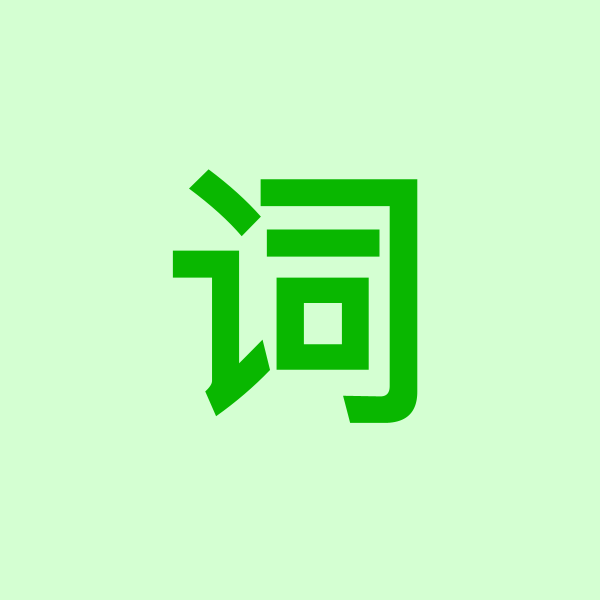
英语单词大百科
“wear”的过去式是“wore”,过去分词是“worn”。
### 音标
* 英音:[weə(r)];[wɔː(r)](过去式);[wɔːn](过去分词)
* 美音:[wer] ;[wɔr](过去式);[wɔrn](过去分词)
### 中文释义
动词(v.):穿;戴;蓄(发、须等);面露;流露;消耗;磨损;(使)变得或显得(worn为形容词)
### 单词起源
“Wear”一词源自中古英语“weren”和“weor(e)”,其最终可以追溯到原始日耳曼语的“*werjan”,意为“携带”或“运送”。
### 单词详细讲解
“wear”是一个不规则动词,表示穿戴衣物、饰品等,或者表示某物的磨损、消耗。它还可以用于描述人的情绪、态度等的外露或表现。
### 助记技巧
1. **谐音法**:“我(wo)热(re)”了就“穿(wear)”上衣服,过去式“wore”可以谐音为“我热(wore)了”,过去分词“worn”可以谐音为“我热(worn)坏了”。
2. **联想法**:想象一个人穿着(wear)旧衣服(worn),因为穿(wore)了很久。
3. **词根词缀法**:虽然“wear”本身没有明确的词根词缀,但可以通过其不规则形式来记忆。
4. **故事法**:编造一个关于某人穿着(wear)旧衣服(worn),并讲述了他过去(wore)的故事。
5. **对比法**:与其他规则动词的过去式和过去分词形式进行对比,如“play-played-played”,强调“wear”的不规则性。
### 常用词组
1. wear out 穿坏;磨损;耗尽
2. wear off 逐渐消失;逐渐减弱
3. in wear 在使用中;在穿着中
4. wear and tear 磨损;消耗
5. wear a smile 带着微笑
### 词根词缀及记忆方法
虽然“wear”作为一个基础词汇,其本身并不包含明显的词根词缀,但可以通过其不规则变化形式来加深记忆。同时,可以将其与其他类似的不规则动词进行联想记忆,如“go-went-gone”,“see-saw-seen”等。
### 单词造句
1. The shoes have worn out after years of wear. (经过多年穿戴,这双鞋已经穿坏了。)
2. The paint on the wall is beginning to wear off. (墙上的油漆开始逐渐脱落。)
3. This dress is still in wear despite being several years old. (尽管这件衣服已经有好几年了,但仍然在穿。)
4. The constant use of the machine caused a lot of wear and tear. (机器的频繁使用导致了很大的磨损。)
5. She always wears a smile on her face. (她总是面带微笑。)
### 名著小说中含有该单词的句子
1. **出处**:《傲慢与偏见》(Jane Austen)
**原文**:“Her clothes were rather neat, and in a peculiar degree becoming, simple and elegant.”
**译文**:“她的衣服相当整洁,而且以一种特别的方式十分合身,既简单又优雅。”
**讲解**:此处的“becoming”可引申为穿着得体,与“wear”相关。
2. **出处**:《简·爱》(Charlotte Brontë)
**原文**:“I have worn it out in nursing you night and day.”
**译文**:“我日夜照顾你,已经把它穿破了。”
3. **出处**:《雾都孤儿》(Charles Dickens)
**原文**:“The shoes he wore were far too large for him, and the socks, which were of a different hue from those in fashion, did not appear to fit him any better.”
**译文**:“他穿的鞋子对他来说太大了,袜子也不是当时流行的颜色,似乎也不太合脚。”
4. **出处**:《飘》(Margaret Mitchell)
**原文**:“The soft cotton dress she wore was faded and worn, but it was clean.”
**译文**:“她穿的柔软棉质连衣裙已经褪色并磨损了,但它是干净的。”
5. **出处**:《杀死一只知更鸟》(Harper Lee)
**原文**:“Jem's overalls were worn at the knees and elbows, and his shirt was sweat-stained.”
**译文**:“杰姆的工装裤在膝盖和肘部都磨破了,他的衬衫也被汗水浸湿了。”
希望以上信息能够帮助你更好地理解和记忆“wear”的过去式和过去分词。